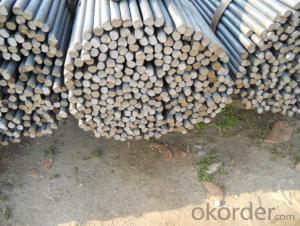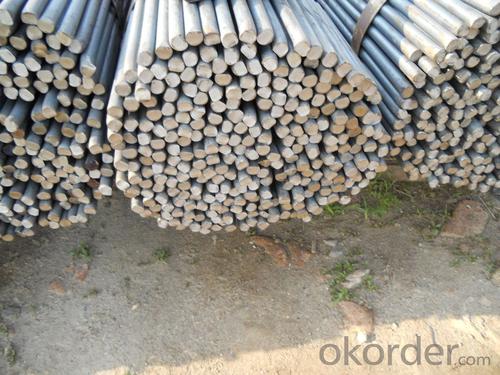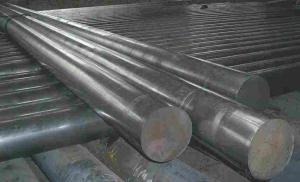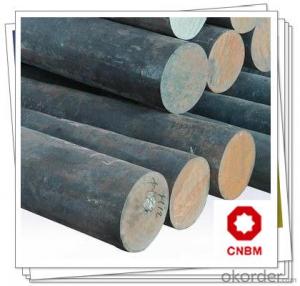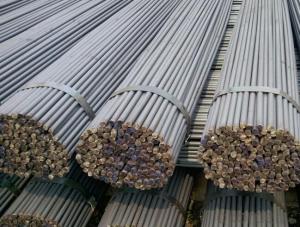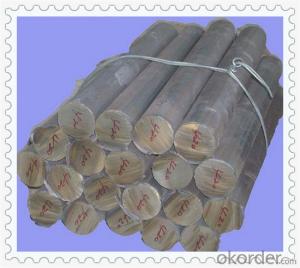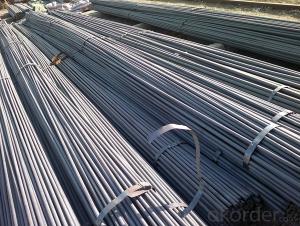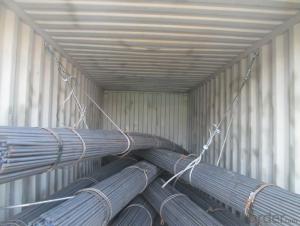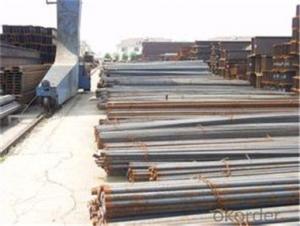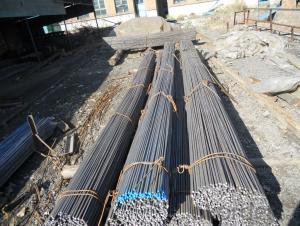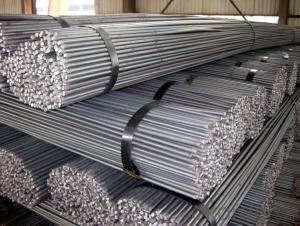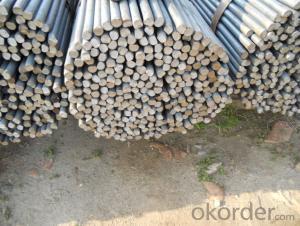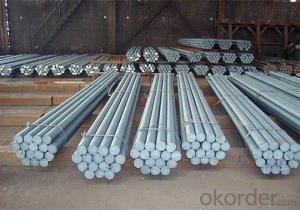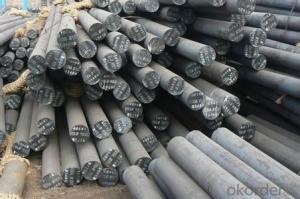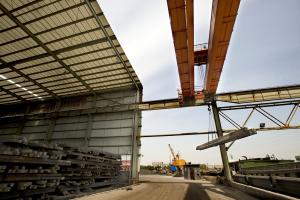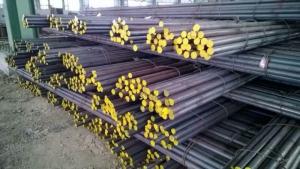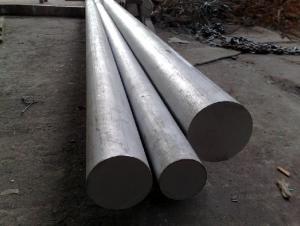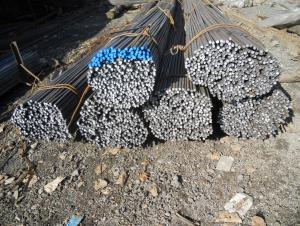Hot Rolled Steel Round Bar High Qulity Made In China JIS ASTM GB
- Loading Port:
- Tianjin
- Payment Terms:
- TT OR LC
- Min Order Qty:
- 50 m.t.
- Supply Capability:
- 20000 m.t./month
OKorder Service Pledge
OKorder Financial Service
You Might Also Like
Specification
Product Description:
OKorder is offering Hot Rolled Steel Round Bar High Qulity Made In China JIS ASTM GB at great prices with worldwide shipping. Our supplier is a world-class manufacturer of steel, with our products utilized the world over. OKorder annually supplies products to European, North American and Asian markets. We provide quotations within 24 hours of receiving an inquiry and guarantee competitive prices.
Product Applications:
Hot Rolled Steel Round Bar High Qulity Made In China JIS ASTM GB are ideal for structural applications and are widely used in the construction of buildings and bridges, and the manufacturing, petrochemical, and transportation industries.
Product Advantages:
OKorder's Hot Rolled Steel Round Bar High Qulity Made In China JIS ASTM GB are durable, strong, and resist corrosion.
Main Product Features:
· Premium quality
· Prompt delivery & seaworthy packing (30 days after receiving deposit)
· Corrosion resistance
· Can be recycled and reused
· Mill test certification
· Professional Service
· Competitive pricing
Product Specifications:
1. Material: Alloy structural steels, carbon structure steels, alloy tool and model steels,etc.
2. Process: EAF + LF + VD + Forged + Heat Treatment (optional)
3. Delivery condition:Hot forged +Rough machined (black surface after Q/T)+ Turned (optional)
4.Technical Data: Chemical Composition, Physical Properties and Mechanical Testing.
5. Test: Ultrasonic test according to SEP 1921-84 3C/c.
Chemical Composition:
C | Si | Mn | P | S | Cr | |
45Cr | 0.42-0.49 | 0.17-0.37 | 0.6-0.9 | Max0.035 | Max0.035 | 0.3 0.4 |
S45C | 0.42-0.48 | 0.15-0.35 | 0.6-0.9 | Max0.030 | Max0.035 | |
1045 | 0.43-0.5 | 0.15-0.35 | 0.6-0.9 | Max0.030 | Max0.050 |
Usage and Applications of Common Steel Round Bar
1. Common Steel Round Bar of 8-25mm, or small round is mostly used for straight bundles supply, and used for steel, bolts and various mechanical parts. While the bigger round bar, or more than 25mm hot rolled bar, is mainly for the manufacture of mechanical parts or for seamless steel billet.
2. Steel round bar is used in construction and a large number of architectural and engineering structures.
3. Besides, we can supply some especial material steel round bar that can be used for main shaft of steamer, hummer shank, with big section and supper force.
Packaging & Delivery of Common Steel Round Bar
Packaging Detail: All goods are packed in bundle with steel strips and shipped by break bulk vessel or container (depend on target market and different ports)
Delivery Detail: 45 days
Trade terms: FOB, CFR, CIF
MOQ: 25 tons per specification; we can negotiate the quantity if the specification is normal or we have stock of one specification.
Weight: The price invoicing on theoretical weight basis or actual weight basis depends on customer’s request.
Shipment: The shipment of bulk break or container is depends on customer’s request and the situation of the port of destination.
Documents given: Full set of original clean on board bill of lading; Original signed commercial invoice; Original packing list; Policy of insurance; Certificate of origin and what the target market needs.
FAQ:
Q1: Why buy Materials & Equipment from OKorder.com?
A1: All products offered byOKorder.com are carefully selected from China's most reliable manufacturing enterprises. Through its ISO certifications, OKorder.com adheres to the highest standards and a commitment to supply chain safety and customer satisfaction.
Q2: How do we guarantee the quality of our products?
A2: We have established an advanced quality management system which conducts strict quality tests at every step, from raw materials to the final product. At the same time, we provide extensive follow-up service assurances as required.
Q3: How soon can we receive the product after purchase?
A3: Within three days of placing an order, we will begin production. The specific shipping date is dependent upon international and government factors, but is typically 7 to 10 workdays.
Q4: What makes stainless steel stainless?
A4: Stainless steel must contain at least 10.5 % chromium. It is this element that reacts with the oxygen in the air to form a complex chrome-oxide surface layer that is invisible but strong enough to prevent further oxygen from "staining" (rusting) the surface. Higher levels of chromium and the addition of other alloying elements such as nickel and molybdenum enhance this surface layer and improve the corrosion resistance of the stainless material.
Q5: Can stainless steel rust?
A5: Stainless does not "rust" as you think of regular steel rusting with a red oxide on the surface that flakes off. If you see red rust it is probably due to some iron particles that have contaminated the surface of the stainless steel and it is these iron particles that are rusting. Look at the source of the rusting and see if you can remove it from the surface.
Images:
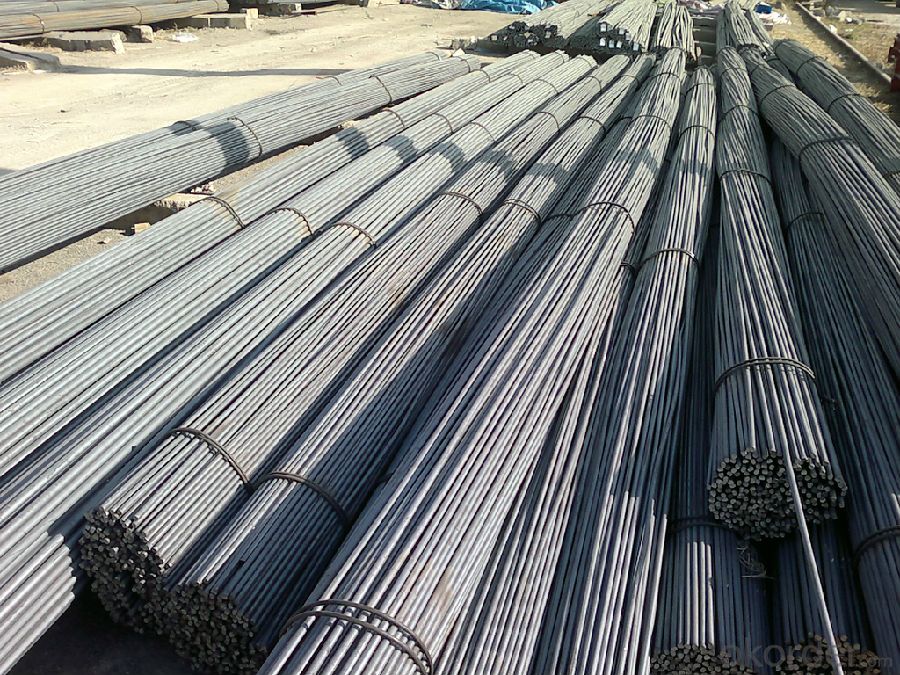
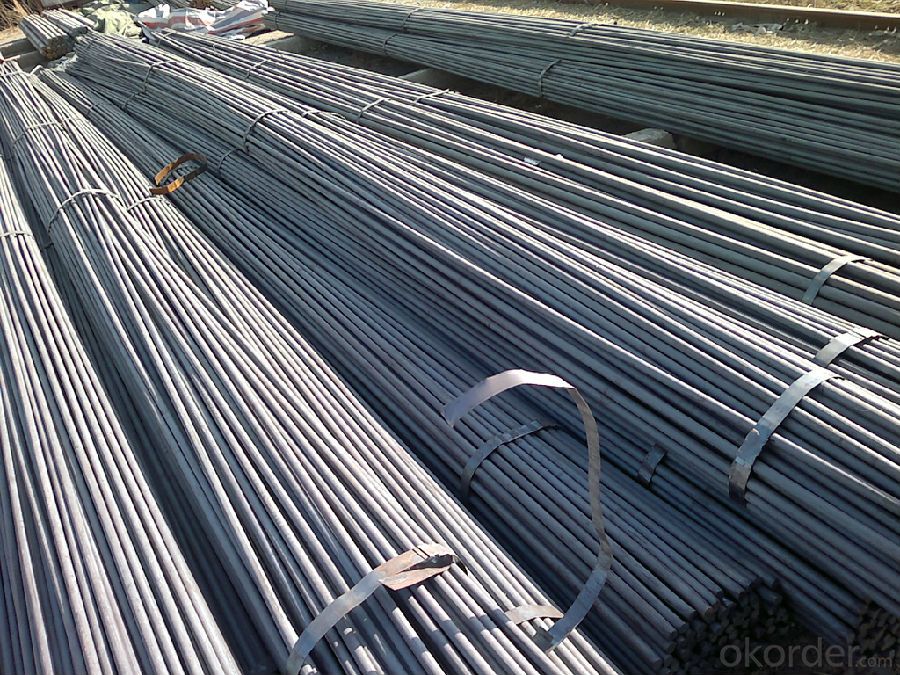
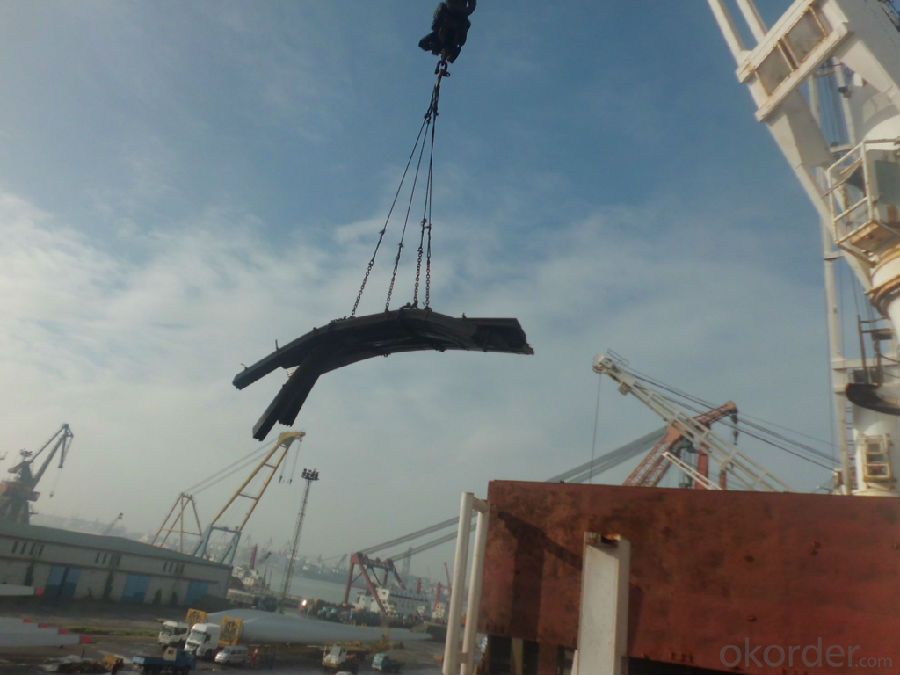
- Q: What are the different surface treatments available for tool steel round bars?
- Some of the different surface treatments available for tool steel round bars include: 1. Nitriding: This process involves diffusing nitrogen into the surface of the tool steel, which improves hardness, wear resistance, and corrosion resistance. 2. Hard Chrome Plating: This treatment involves applying a layer of chromium to the surface of the tool steel, which enhances hardness, wear resistance, and resistance to corrosion. 3. Black Oxide Coating: This treatment involves a chemical reaction that creates a black oxide layer on the surface of the tool steel, providing improved appearance and some corrosion resistance. 4. PVD Coating: Physical Vapor Deposition (PVD) is a process that deposits a thin film coating onto the surface of the tool steel. Different types of PVD coatings can improve hardness, lubricity, and resistance to wear and corrosion. 5. DLC Coating: Diamond-Like Carbon (DLC) coating is a type of PVD coating that incorporates carbon to provide enhanced hardness, low friction, and wear resistance. 6. Powder Coating: This process involves applying a dry powder coating to the surface of the tool steel, which is then cured to create a durable and attractive finish. These surface treatments can be chosen based on the specific requirements of the tool steel application, such as improving wear resistance, reducing friction, enhancing appearance, or providing corrosion resistance.
- Q: Can steel round bars be cut to custom lengths?
- Indeed, it is possible to cut steel round bars to tailor-made lengths. These bars made of steel are adaptable and can be effortlessly cut using different techniques like sawing, shearing, or torch cutting. These approaches enable accurate adjustments to be made to meet specific demands or project necessities. Moreover, steel round bars are often obtainable in standard lengths, but they can be conveniently shortened or elongated by welding separate pieces together. All in all, steel round bars provide versatility in terms of length customization, rendering them suitable for a diverse array of applications.
- Q: What is the difference between a ground and a polished steel round bar?
- A ground steel round bar and a polished steel round bar differ in their surface finish and appearance. A ground steel round bar is subjected to a grinding process, where a grinding wheel or belt is used to remove any surface imperfections, such as roughness or irregularities. This process results in a smooth and even surface finish. Ground steel round bars are often used in applications where precision and tight tolerances are required, such as in machinery or automotive components. On the other hand, a polished steel round bar undergoes a polishing process, where abrasive materials such as polishing compounds or buffing wheels are used to create a high shine and reflective surface. This process enhances the aesthetics of the steel bar, making it more visually appealing. Polished steel round bars are commonly used in decorative applications, architectural projects, or in industries where a visually pleasing appearance is desired, such as jewelry or interior design. In summary, while both ground and polished steel round bars serve different purposes, the main difference lies in their surface finish. Ground steel round bars prioritize precision and smoothness, while polished steel round bars prioritize a shiny and reflective appearance.
- Q: How are steel round bars used in the manufacturing of mining equipment?
- Steel round bars are an essential component in the manufacturing of mining equipment due to their strength, durability, and versatility. These bars are used in various applications throughout the mining industry, ensuring the reliability and longevity of the equipment. One of the primary uses of steel round bars in mining equipment is for the construction of frames and structural components. The bars provide the necessary structural support, ensuring the overall stability and robustness of the equipment. Whether it is for excavators, drilling rigs, or conveyor systems, steel round bars play a crucial role in maintaining the integrity of the machinery. Moreover, steel round bars are commonly utilized in the manufacturing of mining tools and attachments. These bars can be machined and shaped into different forms, such as shafts, pins, and bolts, which are vital for various mining operations. For example, drill bits used for drilling into rock formations are often made with steel round bars due to their ability to withstand high-pressure conditions. In addition, steel round bars are essential for the fabrication of wear-resistant components in mining equipment. The harsh environments in mining, including abrasive materials and extreme temperatures, necessitate the use of durable materials. Steel round bars with specific alloys and heat treatments can be employed to create wear-resistant parts like cutting edges, teeth, and buckets for excavators, ensuring their longevity and performance. Furthermore, steel round bars are also utilized in the production of support structures and safety features in mining equipment. These bars can be used to create roll cages, protective frames, and guardrails, providing a safe working environment for operators and minimizing the risk of accidents. Overall, steel round bars are a vital component in the manufacturing of mining equipment, contributing to their strength, reliability, and performance. Their use in construction, tool fabrication, wear-resistant components, and safety features ensures the durability and efficiency of mining machinery, enabling the industry to operate effectively and safely.
- Q: What is the maximum elongation of steel round bars?
- The maximum elongation of steel round bars depends on various factors such as the type of steel, its composition, and the manufacturing process. However, in general, steel round bars can have elongation values ranging from 10% to 30% before they reach their maximum limit and start to deform permanently.
- Q: What are the advantages of using weather-resistant steel round bars?
- Weather-resistant steel round bars have several advantages. Firstly, they have a higher resistance to corrosion compared to regular steel, making them ideal for outdoor applications or environments with high humidity or exposure to saltwater. Secondly, they have excellent strength and durability, allowing them to withstand harsh weather conditions, such as extreme temperatures, heavy rains, and strong winds. Additionally, these round bars require minimal maintenance, saving time and money in the long run. Overall, weather-resistant steel round bars provide enhanced longevity and performance, making them a reliable choice for various construction and industrial purposes.
- Q: Are steel round bars suitable for use in the manufacturing of springs?
- Yes, steel round bars are suitable for use in the manufacturing of springs. Steel round bars are commonly used in the production of springs due to their high strength and durability. The round shape of the bars allows for easy bending and shaping into various spring designs. Additionally, steel has excellent elastic properties, making it ideal for springs that need to absorb and store mechanical energy. Steel round bars also offer good corrosion resistance, which is important for springs that are exposed to environmental elements. Overall, steel round bars provide the necessary characteristics required for the manufacturing of high-quality and reliable springs.
- Q: What is the maximum copper content allowed for steel round bars?
- The maximum copper content allowed for steel round bars varies depending on the specific grade and industry standards. In general, copper is considered an alloying element in steel and is typically added in small amounts to enhance certain properties. The maximum allowable copper content for most steel round bars is typically around 0.50% to 1.00%. However, it is important to note that this can vary depending on the specific application and grade of steel being used. It is recommended to consult the relevant industry standards or specifications for the specific steel grade and application to determine the maximum copper content allowed.
- Q: What are the different grades of alloy steel round bars for automotive applications?
- Automotive applications commonly utilize alloy steel round bars due to their exceptional strength, durability, and resistance to wear and corrosion. The grading of these bars is typically based on their chemical composition, mechanical properties, and appropriateness for specific automotive uses. Here are several distinct grades of alloy steel round bars frequently employed in automotive applications: 1. 4140/42CrMo4: Renowned for its high tensile strength, good toughness, and excellent fatigue strength, this grade of alloy steel round bars is extensively employed in gears, crankshafts, axles, and suspension components. 2. 8620: Offering exceptional hardenability, this grade of alloy steel round bars can be subjected to heat treatment to attain high strength and toughness. It is commonly utilized in shafts, gears, and camshafts. 3. 4340: Known for its impressive strength and toughness, this grade of alloy steel round bars provides good wear resistance and can be heat treated to achieve even greater hardness and strength. It is often used in connecting rods, crankshafts, and high-stress components. 4. 52100: This high carbon, chromium alloy steel is renowned for its outstanding hardness and wear resistance. It is commonly employed in applications such as bearings and races that require high strength and durability. 5. 316L: Recognized for its exceptional corrosion resistance, particularly in harsh environments, this grade of alloy steel round bars is frequently utilized in automotive applications like exhaust systems, where resistance to corrosion is crucial. 6. 4340M: Specifically designed for high-performance automotive applications, this modified version of the 4340 grade offers improved fatigue strength and toughness. It is suitable for demanding applications, including high-performance engine components. These examples represent only a few of the various grades of alloy steel round bars employed in automotive applications. The selection of a specific grade depends on the requirements of the application, including desired strength, toughness, wear resistance, and corrosion resistance.
- Q: How do steel round bars differ from steel square bars?
- The shape and appearance of steel round bars and steel square bars differ. Steel round bars have a circular cross-section and a cylindrical shape, making them suitable for applications that require strength and stability, such as construction, manufacturing, and engineering. Their circular shape allows for even distribution of stress and load, making them highly resistant to bending or twisting forces. They are commonly used as structural components in buildings, support beams, shafts, and axles. On the other hand, steel square bars have a square cross-section with four equal sides and sharp corners. This shape provides additional advantages in certain applications. Square bars offer better grip and handling due to their flat surfaces, making them easier to hold, stack, or secure during fabrication or installation. They are often utilized in the manufacturing of machinery, tools, frames, and brackets where square edges are necessary for precise alignment or stability. Both steel round bars and steel square bars are available in various grades and alloys, providing different levels of strength, hardness, and corrosion resistance. The choice between the two depends on the specific requirements of the project or application.
Send your message to us
Hot Rolled Steel Round Bar High Qulity Made In China JIS ASTM GB
- Loading Port:
- Tianjin
- Payment Terms:
- TT OR LC
- Min Order Qty:
- 50 m.t.
- Supply Capability:
- 20000 m.t./month
OKorder Service Pledge
OKorder Financial Service
Similar products
Hot products
Hot Searches
Related keywords
